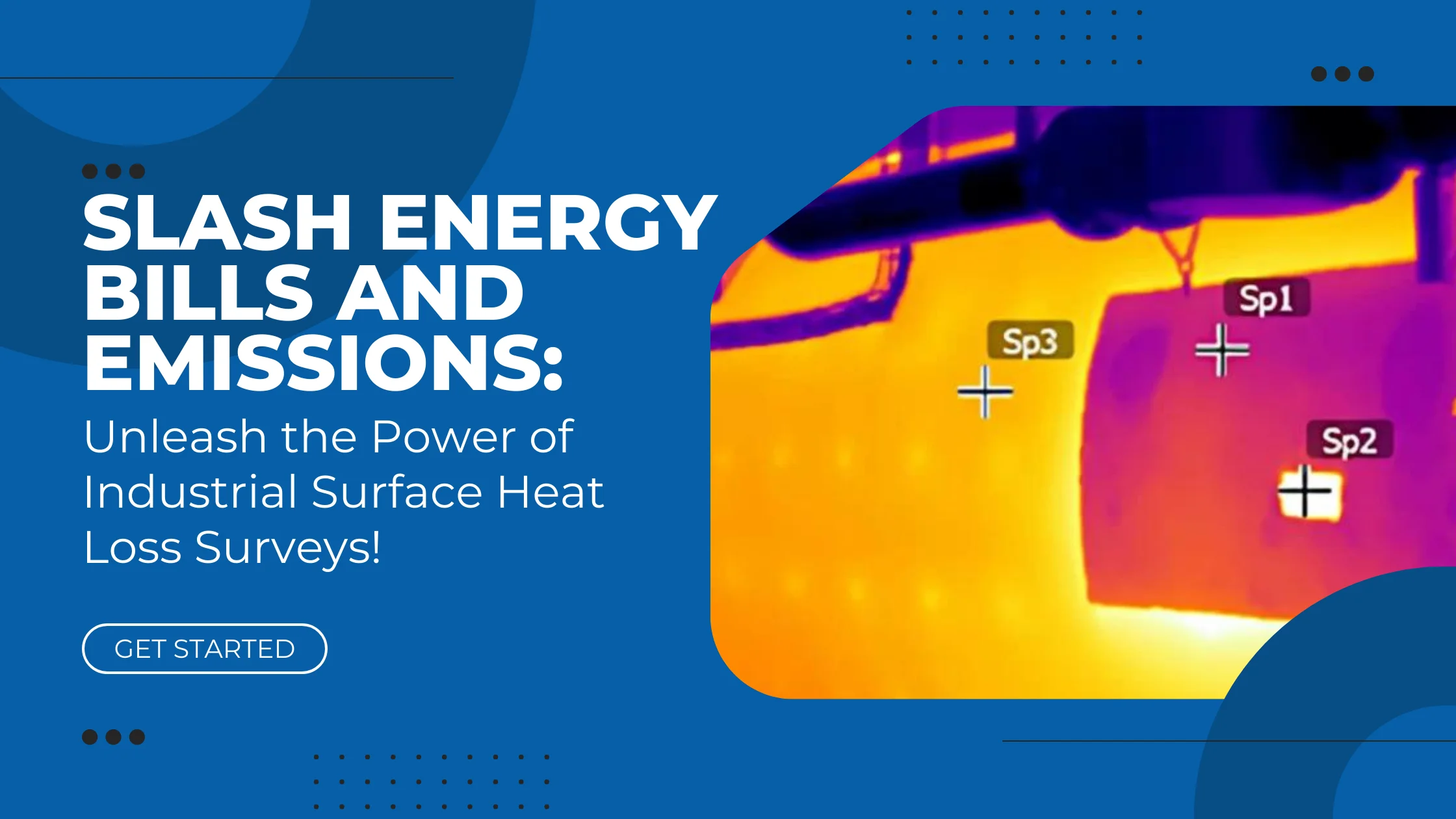Are you tired of spending a fortune to operate and maintain your equipment, only to see excessive energy bills and high carbon emissions? If so, it is time to evaluate the efficiency of your insulation system. Your equipment may lose more heat than you realize through surface losses, leading to increased operating costs and negative environmental impacts.
According to the EiiF Study 2021, 14 Mtoe of energy can be saved by applying energy class C systems according to VDI 4610 Part 1, offering the potential to reduce the EU’s CO₂ equivalent emissions by 40 Mt every year. Upgrading insulation systems to VDI 4610 energy class C will reduce about 88% of the current energy loss in the low-temperature and in middle-temperature levels. About 78% of the energy loss will be reduced in the high-temperature level.
The solution lies in conducting an industrial surface heat loss survey. This survey will provide valuable insights into which areas of your equipment are experiencing skin or surface losses. By identifying these areas, you can determine the most financially feasible and energy-efficient solutions to reduce surface heat loss, improve overall energy efficiency, and boost your bottom line.
In this article, we will delve deeper into the world of industrial surface heat loss surveys and explore their broader significance in helping businesses become more sustainable while also increasing profitability.
What is Industrial Surface Heat Loss Survey?
The industrial surface heat loss survey is a comprehensive assessment of your equipment’s insulation system (or without insulation), aimed at evaluating its energy efficiency level. The survey helps identify areas where skin or surface heat loss occurs, allowing technicians to recommend the most effective course of action to minimize them.
Upon completion, the survey presents crucial financial and environmental implications related to surface losses. By analysing this data, companies can determine the most suitable insulation strategy capable of minimizing skin losses and maximizing returns on investment. The survey’s results provide invaluable insights that enable firms to experience significant cost savings, enhance operational efficiency, and have a positive impact on the environment.
It cannot be overstated how essential conducting an industrial surface heat loss survey is for any company looking to reduce its carbon footprint while boosting profitability. Failure to tackle inefficient insulation systems can lead to higher operating expenses, resulting in decreased profits and increased carbon emissions. Therefore, investing in an industrial surface heat loss survey program remains one of the most reliable ways businesses can achieve their sustainability goals while maintaining profitability.
The Benefits of Conducting an Industrial Surface Heat Loss Survey
An industrial surface heat loss survey is an invaluable tool for businesses looking to achieve their sustainability goals while boosting profitability.
The benefits of conducting this survey program go beyond reducing operating costs and include the following:
- Minimizes Carbon Footprint: By identifying areas where skin or surface heat loss occurs, companies can significantly reduce the amount of energy lost through heat transfer from equipment surfaces, leading to lower carbon emissions.
- Enhances Safety: Addressing surface losses not only improves operational efficiency but also minimizes radiant heat from equipment surfaces, improving the safety and comfort level of workers in proximity to it.
- Improves Efficiency: Poor insulation systems can lead to higher energy consumption rates, resulting in decreased operational efficiency. However, by tackling surface losses, companies can increase operational efficiency and reduce energy consumption rates. According to the EiiF Study 2021, upgrading insulation systems to VDI 4610 energy class C can reduce about 88% of the current energy loss in the low-temperature and middle-temperature levels, and about 78% in the high-temperature level.
- Cuts Down Costs: A meticulously planned insulation solution cuts down maintenance costs by decreasing downtime and extending equipment lifespan. This saves businesses money on repairs and replacements while also boosting profitability overall.
Investing in an industrial surface heat loss survey program is a wise decision for businesses looking to become more sustainable while increasing their bottom line. By reducing carbon emissions, enhancing safety, improving efficiency, and cutting costs, these surveys offer valuable insights that enable firms to experience significant cost savings and have a positive impact on the environment. The EiiF Study 2021 found that 14 Mtoe of energy can be saved by applying energy class C systems according to VDI 4610 Part 1, offering the potential to reduce the EU’s CO₂ equivalent emissions by 40 Mt every year.
Common Reasons for Industrial Surface Heat Losses
Industrial surface losses can be caused by a variety of factors, some of which include:
- Poor Insulation Quality: Insulation materials with inferior quality tend to degrade significantly over time, reducing the efficiency of the insulation system. This results in thermal bridging issues and may lead to dissipation or condensation within the material, resulting in increased heat loss. Inadequate insulation can cause moisture to become trapped, leading to corrosion occurring beneath the insulation (CUI).
- Inadequate Installation Quality: Proper installation of an insulation system is critical for optimal performance. Using improper installation procedures or insufficient thickness during installation leads to gaps in insulating material overlapping areas or incomplete coverage, which leads to increased radiant losses.
- Environmental Changes: Changes in weather patterns or building structure adjustments can cause thermal expansion or contraction, leading to damage to insulating material as well as loosening making it ineffective at containing temperature inside the equipment. These changes result in increased heat loss due to the inefficiency of the insulation system.
- Wear and Tear: Over time, wear and tear on an insulation system can lead to decreased performance, resulting in increased heat loss. This can occur due to ageing or exposure to harsh environmental conditions like chemicals or extreme temperatures.
It is important for businesses to address these factors and implement proper insulation solutions to minimize surface heat losses and maximize energy efficiency. Failure to do so may result in higher operating costs, reduced equipment lifespan, and negative environmental impacts. Therefore, regular inspections and maintenance of insulation systems should be a top priority for any business looking to improve its bottom line while maintaining sustainability goals.
Types of Insulation Solutions Available Today
When it comes to insulation solutions, there are diverse options available in the market catering to specific needs. However, some of the most common ones used today include:
- Fiberglass: This is one of the most inexpensive insulation materials on the market and is known for its excellent thermal resistance properties. It provides an affordable solution for companies looking to improve energy efficiency without breaking the bank.
- Spray Foam: This insulation type expands after application, filling up any voids completely, thus reducing air gaps that lead to convection currents resulting in minimal radiative loss compared to other methods. It is a cost-effective option that delivers exceptional performance while also being easy to install.
- aerogel: Produced using silica aerogel, this highly effective insulation solution mitigates both conductive and convective heat transfer while occupying limited space thanks to its high reflectivity properties. Although more expensive than other insulation types, it provides superior performance, resulting in significant energy savings over time.
The choice of the best insulation solution depends on several factors such as location, equipment type, and budget among others which should be considered before deciding.
The Financial Impact of Addressing Surface Losses
When it comes to implementing an industrial surface heat loss survey program, measuring the return on investment is essential. A comprehensive analysis using updated data can provide precise figures that factor in both direct and indirect expenses, such as lost opportunities caused by unscheduled stoppages due to faulty insulation systems.
According to the EiiF Study 2021, 14 Mtoe of energy can be saved by applying energy class C systems according to VDI 4610 Part 1, offering the potential to reduce the EU’s CO₂ equivalent emissions by 40 Mt every year. This level of annual energy savings is equivalent to the annual energy consumption of 10 million EU households, all households in Hungary, the Czech Republic, and Slovakia, or the annual energy consumption of 20 million cars.
Here are some potential savings that businesses can achieve by optimizing their insulation systems:
- Lifetime Savings: Effective insulation systems can lower operating expenses over the long term, leading to substantial cost savings for your organization. Upgrading insulation systems to VDI 4610 energy class C will reduce about 88% of the current energy loss in the low-temperature and middle-temperature levels, and about 78% of the energy loss in the high-temperature level.
- Tax Rebates: Governments worldwide offer tax incentives to companies that act towards achieving their sustainability goals. By reducing your carbon footprint through improved insulation, you may become eligible for such rebates.
- Reduced Downtime: Upgrading your equipment’s insulation system can improve its uptime, thereby reducing unplanned downtime. This translates into fewer hours spent during reactive maintenance exercises, resulting in reduced overheads associated with immediate fixes due to errors and faults caused by poor insulation systems.
Investing in an industrial surface heat loss survey program can help you identify areas of improvement within your insulation system and assist in designing custom solutions tailored to the specific needs of your equipment. Such a program leverages innovative technology to analyze data accurately, so you can make informed decisions that improve operational efficiency while also making a positive impact on the environment.
Conclusion: The Way Forward with Industrial Surface Heat Loss Survey
As technology continues advancing by the day, there are numerous ways businesses can boost operational efficiency while remaining sustainable globally. Investing in an industrial surface heat loss survey program is one-way companies can achieve their sustainability goals while improving their bottom line positively.
Industrial surface heat loss surveys have emerged as essential tools for business success today. Therefore, it is essential for companies looking forward to increasing their profit margins by curbing operational waste while minimizing negative environmental impacts arising from outdated equipment systems relying heavily on outdated insulation systems- get started with an industrial surface heat loss survey plan today!

